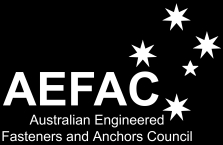Administration
What is the difference between AS 5216 and SA TS 101?
Where may I get a copy of AS 5216?
Regulation
Since the AS 5216 is referenced in the NCC, is it a requirement that I design to this document?
If I design a fastening according to AS 5216 am I complying with the NCC?
What types of anchors need to be designed according to AS 5216?
How do I know if a fastener complies with AS 5216?
As an NCC referenced document, when does AS 5216 come into effect?
What is the difference between a non-conforming and a non-compliant building product?
Scope
What are safety-critical fasteners?
“Anchors for multiple use” – what are they?
Do the quality assurance and torque requirements of AS 1252 apply to fasteners?
Does AS 5216 apply to the design of fasteners for fall arrest and rope access systems?
Concrete
A fastener has been tested and assessed in concrete with a strength of f’c = 20 MPa. Can the fastener be used in stronger concrete?
What types of concrete is AS 5216 applicable to?
What is cracked concrete?
How big is a crack in cracked concrete?
How does cracked concrete change the behaviour of a fastener?
Can I install a fastener in an existing crack?
Can I install a fastener through cracked concrete and into uncracked concrete and design for uncracked concrete?
When do I need to design for cracked concrete?
Why is it conservative to adopt f’ct = 0 as the limiting criterion when performing the stress analysis to check for concrete cracking?
How do I know if a fastener may be designed for seismic actions?
Products
Can any anchor to concrete be designed using AS 5216?
What are the traceability requirements for fasteners designed according to AS 5216?
I want to design a fixing using a fastener that has an ETA and therefore complies with the requirements of AS 5216 Appendix A. Is there any reason why I cannot specify this fastener?
Can I use data published by the anchor supplier with the AS 5216 design procedure?
Can I use products with an ICC approval?
What is the difference between a fastener and an anchor?
What are flooded holes and how to clean them?
Can I use post-installed fasteners in shell of small thickness in concrete planks/slabs having voids/openings?
Where can I get the pre-qualification document of a fastener?
I have found a product that claims to have an ETA. But, the marking/labelling on the packaging/product is different from that in the ETA drawing.
Can I use a pre-qualified chemical with any threaded rod available in market?
Design
Which modes of failure need to be considered during design?
Manual design is cumbersome and time-consuming. Is there an easier way?
Can AS 5216 be used to calculate development length and stress in reinforcement?
How does the depth of the concrete element influence splitting failure due to loading?
AS 5216 does not cover design for fire. Where can I find guidance on design for exposure to fire?
AS 5216 does not cover design for durability. Where can I find guidance on design for durability?
Where can I find guidance for applications not covered by AS 5216?
When designing a fixture containing multiple fasteners, which fastener should I design for?
How do I ensure the correct product is installed on site?
How do I calculate the Working Load Limit (WLL) using AS 5216?
How can edge reinforcement be accounted for in the design of cast-in channel?
Can I use data published by anchor manufacturer/supplier for black steel reinforcing bars to design post installed rebar connection using galvanised bars?
While calculating basic characteristic seismic resistance (R0_k,eq) of chemical fasteners for concrete pry-out failure under shear load in Clause 10 in AEFAC TN10, should I use tau_Rk or tau_Rk,eq ?
Installation
How do I make sure the anchor is installed correctly on site as per the design?
What information do I need to include on the specification?
Are manufacturer’s installation instructions (MII) of fasteners suffice in controlling risks associated with silica dust?
Timber Design
Is AS 1684.1 or AS 1720.3 accepted by National Construction Code and the industry?
References
List of references for referral
Administration
Q: What is the difference between AS 5216 and SA TS 101?
A: AS 5216 and SA TS 101 are both documents by Standards Australia and published through SAI Global. AS 5216 has the status of an Australian Standard, SA TS 10 was published as a technical specification.
AS 5216:2018 superseded SA TS 101:2015. The documents are similar in scope and content but some editorial modifications have been made in the transition.
Both document types, Australian Standard and technical Specification have a similar status. On their own, standards are voluntary, but they become mandatory when they are referenced in the legislation. The current version of the National Construction Code (NCC) 2019 references AS 5216:2018.
AS 5216:2021 is recently published and it supersedes AS 5216:2018. AS 5216:2021 is expected to be referenced in National Construction Code (NCC) 2022.
Q: Where may I get a copy of AS 5216?
A: AS 5216 is a Standards Australia document that is published by SAI Global. The complete reference is:
AS 5216 “Design of post-installed and cast-in fastenings in concrete”, Standard Australia
Regulation
Q: Since the AS 5216:2018 is referenced in the NCC 2019, is it a requirement that I design to this document?
A: The National Construction Code includes performance requirements that must be met using Deemed-to-Satisfy Provisions and/or through a Performance Solution (also known as an ‘Alternative Solution’). AS 5216 forms part of the deemed-to-satisfy provisions referenced under the following:
- NCC Volume One – Clause B1.4(b)(iii)
- NCC Volume Two – Clause 3.0.4(e)
AS 5216 has a limited scope and does not address all performance requirements of the NCC (e.g. design for fire). Refer to the NCC for full details of the performance requirements for buildings.
Q: If I design a fastening according to AS 5216 am I complying with the NCC?
A: The NCC is a performance based code whereby Performance Requirements must be met in order for a solution to meet the relevant compliance level. The performance requirements may be met through Compliance Solutions: a Deemed-to-Satisfy Solution and/or a Performance Solution. Comprehensive information is available from the ABCB.
AS 5216 is a deemed-to-satisfy solution (Clause B1.4(b)(iii) in Vol. 1 and Clause 3.0.4(e) in Vol. 2 of the 2019 NCC) for the determination of structural resistance of materials.
Q: What types of anchors need to be designed according to AS 5216?
A: The scope of As 5216 is limited to the design of fastenings to concrete in safety-critical applications. The scope of fasteners includes post-installed (mechanical and chemical) and cast-in anchor channel. In order for a fastener to be designed according to AS 5216, it must first have been tested and assessed (prequalified) in accordance with AS 5216 Appendix A.
Q: How do I know if a fastener complies with AS 5216?
A: Ask the fastener supplier’s technical support for evidence of compliance of the fastener with AS 5216 Appendix A.
Q: As an NCC referenced document, when does AS 5216 come into effect?
A: The 2019 NCC came into effect on 1st May, 2019. The NCC is given legal effect through the relevant State or Territory Building Control legislation. Enforcement of the NCC is therefore performed at an administrative level at a state or territory level. For full details of adoption of the NCC, refer to the relevant state or territory building regulations.
Q: What is the difference between a non-conforming and a non-compliant building product?
A: The Interim Report of the Senate inquiry into non-conforming building products (Senate Interim Report, 2016) identifies the following definitions:
- Non-conforming building products are ‘products and materials that claim to be something they are not; do not meet required standards for their intended use; or are marketed or supplied with the intent to deceive those who use them’.
- Non-compliant building products are products that are ‘used in situations where they do not comply with the requirements of the National Construction Code [NCC]. A building product can be both non-conforming and non-compliant’.
- An example in the case of fasteners would be:
- A fastener that is labelled as being suitable for use in cracked concrete but which is only suitable for use in uncracked concrete is a non-conforming fastener.
- A fastener that is correctly labelled as being suitable only for use in uncracked concrete but is installed in cracked concrete is deemed to be a non-compliant fastener.
Scope
Q: What are safety-critical fasteners?
A: The term ‘safety-critical’ denotes a risk to the welfare of people or considerable economic loss in the event of failure. In the case of fasteners the responsible engineer will determine whether a certain application is safety-critical.
Q: “Anchors for multiple use” – what are they?
A: Fasteners for multiple use are not fasteners that may be used multiple times. This terminology relates to system robustness and relates to the use of fasteners in statically indeterminate systems securing non-structural elements (e.g. ceiling panels) that incorporate a degree of redundancy such that a progressive collapse mechanism is avoided if a fastener fails. The requirements are defined in EAD 330747 (previously ETAG 001 Part 6) which is summarised as:
i) Minimum number of fixings in the system
ii) Minimum number of fasteners per fixing
iii) Maximum load per fixing point
The redundancy in the system is included so that excessive slip or failure of one fastener does not overload neighbouring fasteners and compromise serviceability requirements or structural integrity. This design is frequently adopted in non-structural systems that may be susceptible to progressive collapse such as a ceiling system.
Q: Do the quality assurance and torque requirements of AS 1252 apply to fasteners?
A: Fasteners which are covered in AS 5216 do not fall under the scope of AS/NZS 1252 (High-strength steel fastener assemblies for structural engineering). Therefore, the quality assurance certificate and torque application requirements specified in AS/NZS 1252 do not apply to the fasteners designed in accordance with AS 5216. Quality assurance for fasteners covered in AS 5216 is part of the prequalification requirements in Appendix A of AS 5216. A fastener covered by AS 5216 with an ETA would automatically satisfy the respective QA requirements of Appendix A of AS 5216. Any torque requirements for fasteners complying with AS 5216 would be specifically specified in the relevant ETA or manufacturer installation instructions.
Q: Does AS 5216 apply to the design of fasteners for fall arrest and rope access systems?
A: Intended use of fasteners is reported in the pre-qualification document (such as ETA) of the fasteners. It is recommended to contact fastener manufacturer or supplier for the suitability of the fasteners to be used in fall arrest and rope access systems. Additional requirements are available in other relevant standards such as AS 1891 or AS/NZS 4488. Furthermore, proper design, installation by competent personnel in accordance with MII and regular inspection are key elements for the safety critical application including fall arrest and rope access systems.
Concrete
Q: A fastener has been tested and assessed in concrete with a strength of f’c = 20 MPa. Can the fastener be used in stronger concrete?
A: The function of a fastening to concrete relies on a complex interaction with the substrate that is related to three mechanisms: friction, bond, or mechanical interlock (or a combination thereof). Modifying the strength of the substrate influences the function of the fastener and the characteristics of the mechanism upon which it derives its strength. An increased concrete strength may result in a smoother drilling operation, reducing friction resistance for mechanical anchors and bond strength for chemical anchors. In the case of mechanical interlock an increase in concrete strength may cause a steel-related mode of failure. If the mode of failure has not been detected during prequalification it is not possible to accurately predict the performance. The design of a fastening according to AS 5216 must only be within the scope of the fastener’s prequalification according to AS 5216 Appendix A. The design of a fastening outside the scope of the fastener’s prequalification is at the discretion of the responsible engineer who may also seek guidance from the fastener supplier’s technical support.
Q: What types of concrete is AS 5216 applicable to?
A: AS 5216 is applicable only to normal-class concrete (according to AS 1379) within a compressive strength range of 12 – 90 MPa determined via cylinder tests and a minimum age of 28 days. For the purpose of design, f’c < 60 MPa. AS 5216 does not currently cover the performance of fasteners in concrete that includes cement substitutes (i.e. geopolymers) or reinforcement other than deformed bars (e.g. steel fibre). Full details are provided in AS 5216:2018 Cl 2.4
Q: What is cracked concrete?
A: The condition of the concrete – cracked or uncracked – has implications on the selection of a suitable fastener as well as fastener design. For the purpose of fastener design, cracked concrete is any concrete whose tensile strength may be exceeded at any time after the fastener has been installed, resulting in a crack that may pass through the plane of the fastener. Cracks may develop due to multiple factors such as the discontinuity introduced due to drilling, hoop stresses developed by the fastener due to installation (e.g. expansion fasteners) and loading, as well as other factors.
Q: How big is a crack in cracked concrete?
A: The definition of cracked concrete is limited to concrete containing crack widths limited to a maximum width equal to 0.3 mm. The prequalification of a fastener for cracked concrete (EAD or ETAG 001 Options 1 – 6) requires the fastener to be subjected to a crack movement test comprising 1000 cycles with the crack width ranging from 0.1 – 0.3 mm while a constant tension load is applied to the fastener. At the conclusion of the test the tension capacity of the fastener is determined to ensure it has not been compromised by the presence of the crack. This test is intended to ensure that the fastener performs in a predictable manner in cracked concrete. Details of the prequalification for post-installed fasteners are outlined in ETAG 001 or EAD 330232 (mechanical fasteners)/ EAD 330008 (bonded fasteners)/ EAD 330499 (anchor channels). AS 5216 permits the design of fasteners to cracked concrete only if the fastener has been suitably prequalified (refer to EAD 330232 Table 1.1, or ETAG 001 Part 1, Table 5.3 Options 1 – 6 for mechanical fasteners).
Q: How does cracked concrete change the behaviour of a fastener?
A: A fastener may only be used in cracked concrete if it has been prequalified for use in cracked concrete, viz., EAD 330232 or ETAG 001 Options 1 – 6 for mechanical fasteners. The performance of a fastener in cracked concrete may only be demonstrated through an appropriate testing and assessment program (e.g. EAD 330008, EAD 330232, or EAD 330499 or ETAG 001).
In general, there is a reduction in the strength of a fastener when used in cracked concrete relative to the strength in uncracked concrete. Additionally, there is an expected reduction in stiffness as illustrated schematically in Figure 4.1.
If a fastener that is only prequalified for use in uncracked concrete is used in cracked concrete it may exhibit unpredictable behaviour such as uncontrolled slip or a change of failure mode. Displacement-controlled expansion fasteners (‘drop-in anchors’) are not suitable for use in cracked concrete since they offer no follow-up expansion capacity to remain engaged with the concrete as it separates due to the formation of a crack.
 |
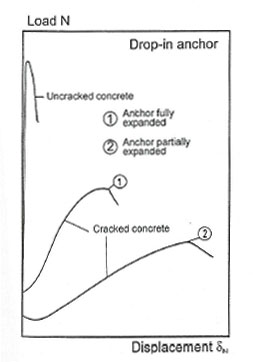 |
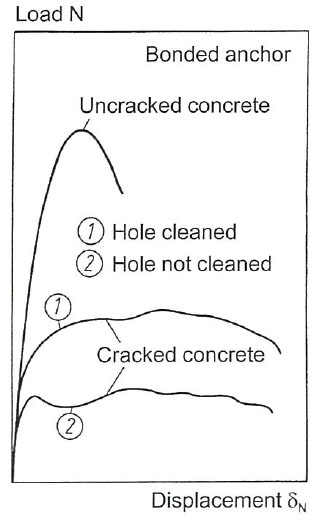 |
|
||
Q: Can I install a fastener in an existing crack?
A: No. The term ‘cracked concrete’ refers to the condition of the concrete after installation and throughout the fastener’s service life. It does not permit the fastener to be installed in an existing crack. The fastener must be suitably qualified in accordance with AS 5216 Appendix A in order to be eligible for use in cracked concrete.
Q: Can I install a fastener through cracked concrete and into uncracked concrete and design for uncracked concrete?
A: No. The fastener engages with the concrete to a depth defined by the ‘effective embedment depth’ (hef). If the stress criterion of Equation (3.3) in AS 5216 demonstrates cracking may develop in the zone where a concrete cone may form, the fastener design must be performed for cracked concrete using a suitably prequalified fastener. Figure 4.2 illustrates how cracks may intersect the formation of a concrete cone.
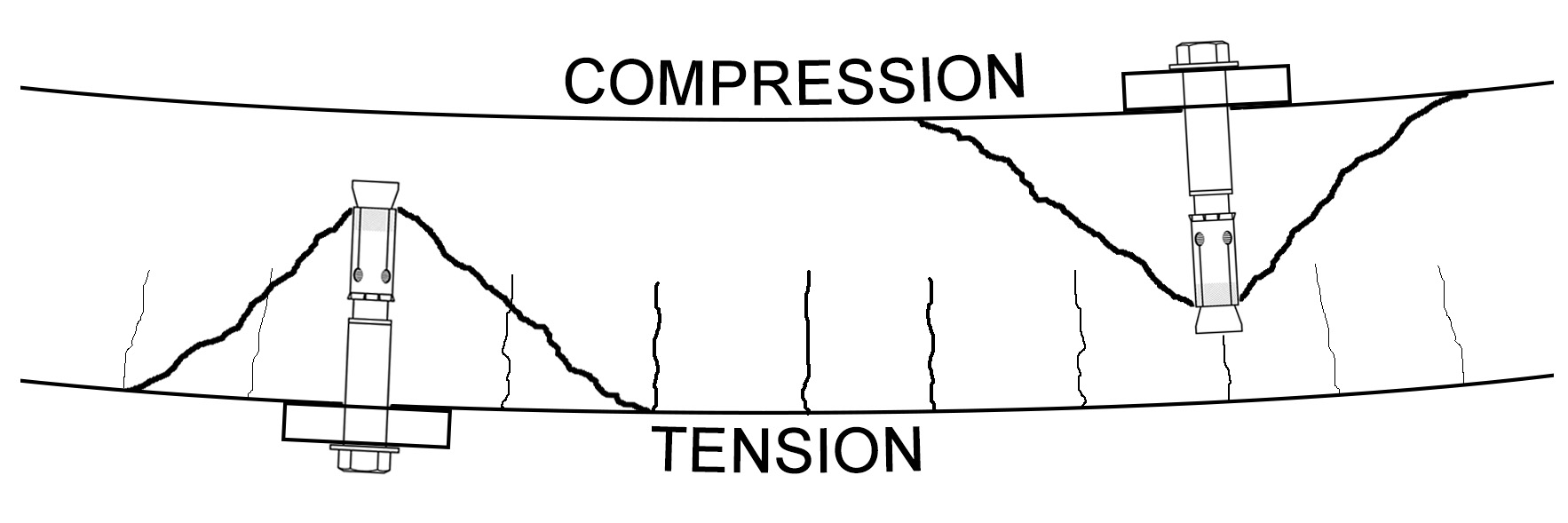
Q: When do I need to design for cracked concrete?
A: For the purpose of design it should be assumed that the concrete is cracked unless it may be demonstrated via AS 5216 Equation (3.3) that the combination of stresses in the concrete attributed to extrinsic factors and the stresses in the concrete attributed to intrinsic factors, at any point in time throughout the fastener’s service life, do not exceed the cracking (tensile) strength of the concrete. If the combination of these stresses does not exceed the tensile strength of the concrete throughout the service life of the fastener, the fastening design may be performed for uncracked concrete.
A fastener prequalified for cracked concrete may be used in uncracked concrete. Conversely, a fastener that has a prequalification limited to uncracked concrete may not be used in cracked concrete. The presence of a crack results in a significantly different stress distribution in the concrete (refer to Figure 4.3).

Q: Why is it conservative to adopt f’ct = 0 as the limiting criterion when performing the stress analysis to check for concrete cracking?
A: The conservative assumption to adopt the condition of f’ct = 0 reflects a concrete with zero tensile strength. For example, if the concrete has a characteristic compressive strength (f’c) equal to 32 MPa, according to AS 3600 Cl. 3.1.1.3 the uniaxial tensile strength of concrete (f’ct) is calculated to equal 2 MPa. Depending on the design engineer’s certainty in the assumptions, they may elect to adopt the calculated value of f’ct or assume conservatively, that f’ct = 0.
Q: How do I know if a fastener may be designed for seismic actions?
A: In order to be eligible for applications involving seismic loading a fastener should pass specific testing and assessment requirements. Fasteners used in seismic applications require a more demanding prequalification regime that is above what is required for functioning in cracked concrete under static or quasi-static actions. The European testing and assessment procedure is provided in EOTA TR 049 “Post-installed fasteners in concrete under seismic action” (previously ETAG 001 Annex E “Assessment of anchors under seismic action”). Design provisions for anchors under seismic loading are currently provided in AS 5216:2021
Products
Q: Can any anchor to concrete be designed using AS 5216?
A: No. The scope of AS 5216 covers mechanical and chemical post-installed anchors as well as cast-in anchor channel. Additionally, in order to be compatible with the design provisions of AS 5216, the anchors must first be prequalified in accordance with AS 5216 Appendix A. A specific testing and assessment procedure must be followed in order to develop the appropriate parameters for use in the design equations. Products that have a current European Technical Assessment/Approval (ETA) are compatible with AS 5216 via minor amendment to notation outlined in AS 5216 Appendix B.
Q: What are the traceability requirements for fasteners designed according to AS 5216?
A: To comply with the National Construction Code (NCC), all fasteners need to be independently tested and assessed as per Appendix A of AS 5216. The assessment report (such as an ETA) should include the traceability information pertaining to the tested fasteners covered within the report, such as the name and address of the manufacturer, the product identification number, and the date of production.
The specific traceability information may vary depending on the type of fasteners involved. However, the manufacturer or supplier should be able to provide the necessary information, such as batch certificates, upon request.
If batch certificates are required, it is recommended to communicate this requirement to the fastener supplier during the enquiry/ordering process. Please be aware that batch-specific certificates may not be available for products that have already been sold.
Q: I want to design a fixing using a fastener that has an ETA and therefore complies with the requirements of AS 5216 Appendix A. Is there any reason why I cannot specify this fastener?
A: The ETA needs to be relevant to the scope of the intended application.
ETAs are awarded on the basis of satisfying a limited scope of testing and assessment. In the case of post-installed fasteners there are 12 different Options that a fastener may be awarded. The Options related specifically to an intended application for which the fastener is considered to be fit for purpose. The different Options relate to:
- i) Prequalification for cracked or uncracked concrete
- ii) Low or low and high strength concrete
- iii) Single strength for all directions or direction-dependent strength
- iv) Edge or spacing effects present or no spacing and edge effects
- v) Comprehensive or simplified design methodology
In the case of an ETA for anchor channel awarded on the basis of an EAD, it is optional for the anchor channel to be prequalified for fatigue.
Q: Can I use data published by the anchor supplier with the AS 5216 design procedure?
A: Provided the data has been developed in accordance with the requirements of AS 5216 Appendix A, the supplier/manufacturer should publish information to this effect. If you are uncertain, contact the technical support of the anchor supplier to seek clarification on whether their product complies with the requirements of AS 5216 Appendix A.
Q: Can I use products with an ICC approval?
A: Anchor products that have a US prequalification (i.e. ICC approval) are compatible with the design guidelines published in ACI-318. Although the US framework for anchor prequalification and design is similar to AS 5216, it is not identical. The U.S. ICC approvals are comparable to the prequalification requirements of AS 5216 Appendix A; however they are not compatible with the parameters and design equations of the AS 5216 design model. Therefore, these fasteners must be designed according to the ACI 318 design methodology to become a performance solution.
Q: What is the difference between a fastener and an anchor?
A: These two terms are frequently used to describe the same thing: a device connecting an element to concrete. In Australian practice a fastener installed in concrete may be referred to as an ‘anchor’, such as ‘mechanical anchor’ and ‘chemical anchor’.
Q: What are flooded holes and how to clean them?
A: Flooded holes mean the holes filled with water. The pressure of the water is not considered in the flooded holes and thus the under water conditions / submerged holes cannot be classified as flooded hole. The cleaning sequence for the flooded holes is flush-brush-flush rather than blow-brush-blow for dry holes. For the detailed cleaning and installation procedure, MII should be followed.
Q: Can I use post-installed fasteners in shell of small thickness in concrete planks/slabs having voids/openings?
A: When post-installed anchors are installed in the thin shell below the voids of slab systems that include large voids the performance of the anchors is product dependent. AEFAC has conducted experiments using a thin shell concrete element with a shell thickness of 20mm as shown in Figure 5.1. 10mm Screw bolt anchors of 50mm length and 10mm Drop-in anchors of 30mm length from different manufacturers were used in the experiment. A large variance in behaviour was observed for both types of fasteners.
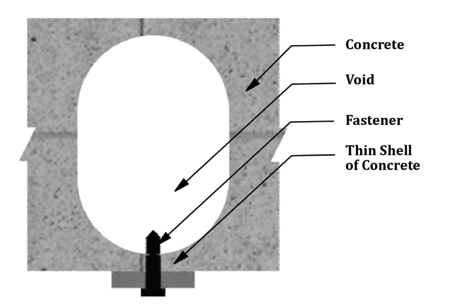
Some fasteners would work well in thin shell and others may not work well in such applications. Therefore, the design data would have to be based on specific fastener used in specific concrete properties.
The results may not be suitable for extrapolation for different combinations of products and concrete properties and shell thickness.
Q: Where can I get the pre-qualification document of a fastener?
A: The product which has been prequalified according to Appendix A of AS 5216 should have a pre-qualification document. The pre-qualification document for the product should have a unique number (such as ETA number or test report number) to allow tracing of the design data for that product. The pre-qualification document number is usually labelled on the product packaging. If the packaging does not have such details, manufacturer/supplier should provide the details upon request.
Q: I have found a product that claims to have an ETA. But, the marking/labelling on the packaging/product is different from that in the ETA drawing.
A: The marking/labelling on the packaging/product should be exactly the same as that in the drawings of the corresponding ETA. If the marking on the product is different than that which is illustrated in the ETA, then the ETA is not valid for that product.
Q: Can I use a pre-qualified chemical with any threaded rod available in market?
A: Chemical and threaded rod are components of a chemical anchoring system. Pre-qualification report contains the details of both components.
However, if these components are sourced from different sources, they may not be compatible or suitable for the intended application. Therefore, it is important to consult the supplier/manufacturer of the chemical anchor to ensure that the chemical and threaded rod meet the specifications and requirements of the system, and that they are installed and used correctly.
Design
Q: Which modes of failure need to be considered during design?
A: There are many different modes of failure needing to be considered during design, depending on the type of anchor, the loading conditions, characteristics of the substrate and details of the installation. Some modes of failure originate in the fastener, some originate in the substrate, others depend on the fastener-substrate interaction. The mode of failure may change as the characteristics of installation and substrate change.
Full details of the modes of failure requiring verification for post-installed and cast-in fasteners are provided in AS 5216 Clause 3.4.
Q: Manual design is cumbersome and time-consuming. Is there an easier way?
A: Yes – software. The design for a single anchor may take a considerable amount of time owing to the different modes of failure needing to be considered and the complexity of the design methodology. Fortunately, most reputable anchor suppliers provide suitable software that is available for download free of charge. Most software packages will generate a comprehensive report that details the calculation for strength. AS 5216 is based on the European design methodology. For further guidance on how to use anchor design software, contact the technical support from your preferred supplier.
Q: Can AS 5216 be used to calculate development length and stress in reinforcement?
A: AS 3600 Section 13 provides the design method for calculating stress development in (cast-in) reinforcement. The design procedure provided in AS 5216 is restricted to design for shallow anchorage (hef < 20dnom) failure involving concrete modes of failure and steel fracture. The design methodology is not applicable to the calculation of stress development in the metal component (reinforcement). The design is limited by data published by the anchor manufacturer in accordance with AS 5216.
Note: AEFAC has published a technical note on “Post-installed rebar connection” for the design of post installed rebar connections. The technical note can be downloaded from resources page.
An informative note has been added in AS 5216 for the design of post-installed rebar connections which refers to the AEFAC technical note on “Post-installed rebar connection”
Q: How does the depth of the concrete element influence splitting failure due to loading?
A: Provided the depth of the concrete member is greater than minimum concrete depth hcr,sp corresponding to characteristic edge distance for splitting failure (ccr,sp), splitting failure will not occur due to loading.If either hcr,sp is reduced splitting failure may occur.
One method (AS 5216:2018 Clause 6.2.6.2(b)) to avoid splitting due to loading is to ensure both the following conditions are met:
- The depth of the concrete member is no less than the minimum concrete member depth (h > hcr,sp) prescribed in the product’s prequalification and either, and
- Edge distance in all directions is greater than the characteristic edge distance for splitting failure (c > ccr,sp for single fasteners, c > 1.2ccr,sp for fastener groups)
Note:SA TS 101 includes a misprint for the verification for splitting failure due to loading. Clause 6.2.5.2 (a) should read “The concrete member depth is h > hcr,sp for a given value ccr,sp and both of the following conditions are met:”
Q: AS 5216 does not cover design for fire. Where can I find guidance on design for exposure to fire?
A: AEFAC recommends you seek guidance from your supplier’s technical support to assist you in developing solutions for applications requiring design for exposure to fire. Guidance may also be found in the EN 1992-4, EOTA TR020 and EOTA TR082.
Q: AS 5216 does not cover design for durability. Where can I find guidance on design for durability?
A: At present the best source of information on durability considerations for fastening design is via technical support provided by the fastener manufacturer/supplier.
Q: Where can I find guidance for applications not covered by AS 5216?
A: For applications not covered under the scope of AS 5216:2018, additional guidance specific to the design of fasteners in concrete may be found in the following references:
- Design for durability: EN 1992-4 “Eurocode 2: Design of concrete structures – Part 4: Design of fastenings for use in concrete”
- Design for exposure to fire: EOTA Technical Report 020 “Evaluation of anchorages in concrete concerning resistance to fire”
- Design for fatigue: EN 1992-4 “Eurocode 2: Design of concrete structures – Part 4: Design of fastenings for use in concrete”
- Fasteners for lifting, transport and erection: AS 3850.1:2015 “Prefabricated concrete elements – Part 1: General requirements”
Q: When designing a fixture containing multiple fasteners, which fastener should I design for?
A: In the case of a fixture containing multiple post-installed fasteners the most unfavourable fastener is determined according to the load on the fastener and the available resistance depending on edge distance and spacing. All fastenings in a fixture should be of the same type in order to avoid a fastener attracting a greater proportion of the load due to a relatively greater stiffness compared with other fasteners in the fixing.
Q: How do I ensure the correct product is installed on site?
A: It is imperative the fastener installed on site is the same as the fastener designed for. Different fasteners that have similar geometry, may look similar, and may even be from the same manufacturer can have very different performance characteristics. It is dangerous to substitute products without the approval of the responsible engineer.
In order to ensure the correct product is installed, ensure a complete and accurate fastener specification is provided on the construction drawings. Recommendations for the information to be included on construction drawings for fastenings to concrete are provided in the AEFAC Technical Note “Guideline for the specification of fastenings to concrete – engineering general notes” that is freely available from the resources page.
Q: How do I calculate the Working Load Limit (WLL) using AS 5216?
A: Working Stress Design (WSD) is a method of proportioning structural members and connections, such that elastically computed stresses produced in the members by nominal loads do not exceed specified allowable stresses. A factor of safety is used to account for uncertainties and ensures the structure remains well within the elastic range. The method has many limitations and has been superseded by the more rational and accurate reliability-based Limit State Design methodology. An illustration of the two methods is provided in Figure 4. The WSD method assumes any variability in the loading or strength is the same for different design scenarios.
Using the WSD method the Working Load Limit (WLL) may be calculated as follows:

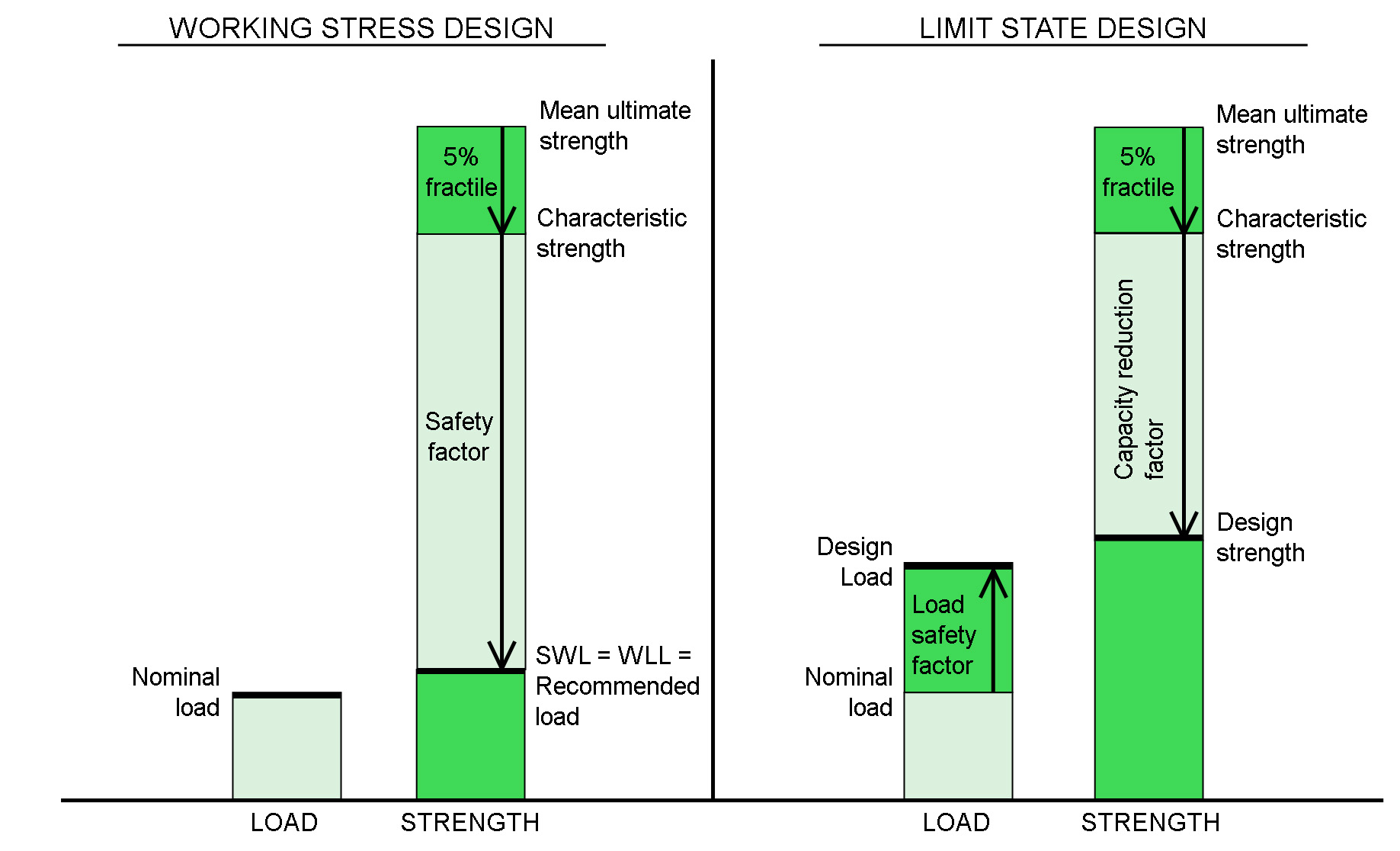
Q: How can edge reinforcement be accounted for in the design of cast-in channel?
A: The calculation for strength against concrete edge failure (VRk,c) for cast-in anchor channel that is given in AS 5216 does not account for the contribution of supplementary reinforcement. In order to account for the contribution of supplementary reinforcement in the calculation of the concrete edge failure mode, an additional parameter accounting for edge reinforcement (ψre,V) is introduced to a revised calculation for the strength against concrete edge failure:
Note: In SA TS 101:2015, there is a typo in Equation 7.22 to calculate the VRk,c. The factor ψre,V is missing in the equation. The equation should be:
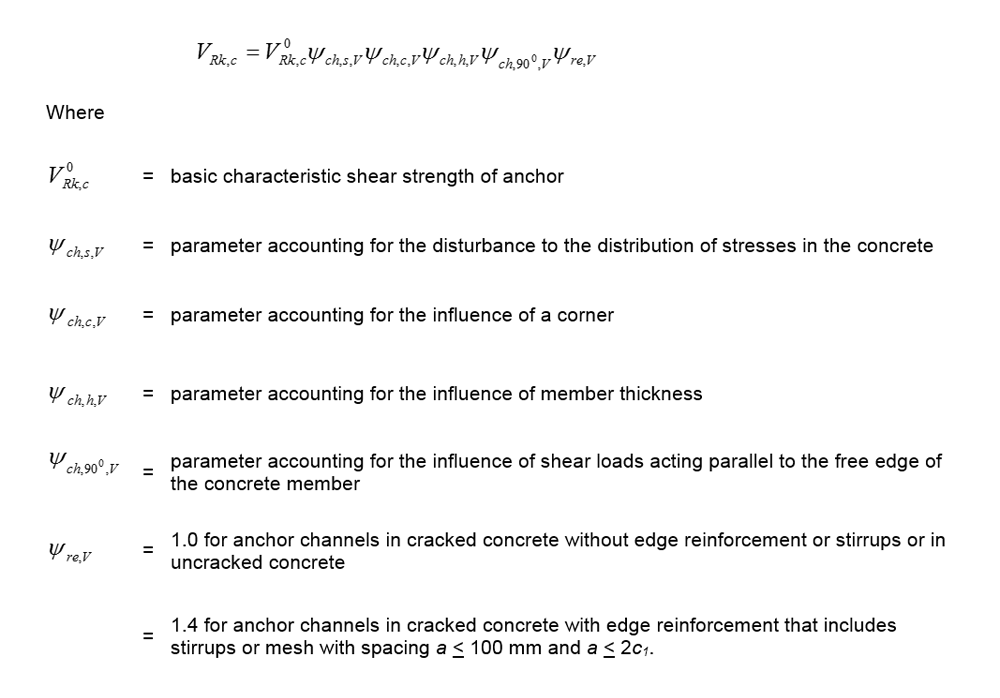
Q: Can I use data published by anchor manufacturer/supplier for black steel reinforcing bars to design post installed rebar connection using galvanised bars?
A: The performance of post-installed reinforcing bar depends on several parameters including surface roughness and lug size and patterns. AEFAC has conducted confined pull-out tests using epoxies and black and HDG reinforcing bars. The difference in bond strength between black steel and HDG rebars was not significant. It is important to note that the lug size and pattern should be same for both reinforcing types. For the project specific requirements, please contact anchor manufacturer or supplier
Q: While calculating basic characteristic seismic resistance (R0_k,eq) of chemical fasteners for concrete pry-out failure under shear load in Clause 10 in AEFAC TN10, should I use tau_Rk or tau_Rk,eq ?
A: The pry-out capacity of a fastener depends on the tensile capacity of the fastener to concrete cone failure and pull-out failure. The pry-out capacity should be determined in accordance with AS 5216 Clause 7.2.4. The tensile capacity of the fastener for pull-out failure should be the seismic pull-out capacity and hence, tau_Rk,eq should be used
Installation
Q: How do I make sure the anchor is installed correctly on site as per the design?
A: Correct installation is imperative to ensure the designer’s intent is met. In order to ensure correct installation the following two steps are required:
1. Ensure an accurate and complete specification is provided. Recommendations are provided in the AEFAC Technical Document “Guideline for the specification of fastenings to concrete - engineering general notes” on the resources page.
2. AS 5216 Appendix B Clause B2 recommends the installer is competent and suitably qualified through the AEFAC Installer Certification Program and/or a specific training program from the product supplier. For further information on the AEFAC Installer Certification Program refer to the certification page.
Installation of fasteners by personnel not suitably competent may jeopardise the safety of the project.
Q: What information do I need to include on the specification?
A: The information required on a specification should ensure the following:
i) The installer is sufficiently qualified to perform the installation.
ii) Sufficient information that will enable the contractor to select the correct tools and to install the anchor as per the design.
iii) Sufficient detail is provided to ensure that it is not possible to procure an unsuitable product.
Details of sample specifications may be found on the resources page.
Q: Are manufacturer’s installation instructions (MII) of fasteners suffice in controlling risks associated with silica dust?
A: The manufacturer’s installation instructions provide minimum requirements for anchor installation to ensure that anchor is installed correctly to achieve the structural performance assumed in the design. However, dust management control is not covered by MII. Additional measures may be necessary to control the risks associated with exposure to silica dust (respirable crystalline silica) from drilling into concrete/masonry and cleaning the drilled holes. The control measures may be site/job specific. The Work Health and Safety (WHS) requirements may vary between states and jurisdictions. For suitable control measures of silica dust, contact your local Health and Safety Representative (HSR), and/or state and territory or national WHS authorities.
The following links provide useful information:
1. National guidance material on “Working with silica and silica containing products”
Timber Design
Q: Is AS 1684.1 or AS 1720.3 accepted by National Construction Code and the industry?
A: AS 1684.1 (1999) has been used to derive the design tables in AS 1684.2, AS 1684.3 and AS 1684.4. The National Construction Code (NCC, 2022) references AS 1684.2, AS 1684.3 and AS 1684.4. AS 1720.3 (2016) has superseded AS 1684.1 (1999). It is expected that AS 1720.3 is adopted for the development of new design tables.
References
- AEFAC Technical Note “Guideline for the specification of fastenings to concrete – engineering general notes” on the resources page.
- AEFAC Technical Note “Post-installed rebar connection” on the resources page
- AS 3600:2018 “Concrete structures”, Standards Australia
- AS 3850.1:2015 “Prefabricated concrete elements – Part 1: General requirements”, Standards Australia
- AS 5216:2018 “Design of post-installed and cast-in fastenings in concrete”, Standards Australia
- AS 5216:2021 “Design of post-installed and cast-in fastenings in concrete”, Standards Australia
- EAD 3300008 “Anchor channels”, European Organisation for Technical Assessment, www.eota.eu
- EAD 330232 “Mechanical Fasteners for Use in Concrete”, European Organisation for Technical Assessment, www.eota.eu
- EAD 330474 “Fasteners for use in concrete for redundant non-structural systems”, European Organisation for Technical Assessment, www.eota.eu
- EAD 330499 “Bonded Fasteners for Use in Concrete”, European Organisation for Technical Assessment, www.eota.eu
- Eligehausen, R., Mallee, R. and Silva, J. F., 2006, “Anchorage in Concrete Construction”, Ernst & Sohn, Berlin, Germany
- ETAG 001 Part 1 “Guideline for European Technical Approval of metal anchors for use in concrete – Part one: anchors in general”, European Organisation for Technical Assessment, www.eota.eu
- ETAG 001 Part 2 “Guideline for European Technical Approval of metal anchors for use in concrete – Part two: torque-controlled expansion anchors”, European Organisation for Technical Assessment, www.eota.eu
- ETAG 001 Part 1 “Guideline for European Technical Approval of metal anchors for use in concrete – Part three: undercut anchors”, European Organisation for Technical Assessment, www.eota.eu
- ETAG 001 Part 1 “Guideline for European Technical Approval of metal anchors for use in concrete – Part four: deformation-controlled expansion anchors”, European Organisation for Technical Assessment, www.eota.eu
- ETAG 001 Part 1 “Guideline for European Technical Approval of metal anchors for use in concrete – Part five: bonded anchors”, European Organisation for Technical Assessment, www.eota.eu
- ETAG 001 Part 1 “Guideline for European Technical Approval of metal anchors for use in concrete – Part six: anchors for multiple use for non-structural applications”, European Organisation for Technical Assessment, www.eota.eu
- ETAG 001 Part 1 “Guideline for European Technical Approval of metal anchors for use in concrete – Annex A: details of test”, European Organisation for Technical Assessment, www.eota.eu
- ETAG 001 Part 1 “Guideline for European Technical Approval of metal anchors for use in concrete – Annex B: tests for admissible service conditions detailed information”, European Organisation for Technical Assessment, www.eota.eu
- ETAG 001 Part 1 “Guideline for European Technical Approval of metal anchors for use in concrete – Annex E: assessment of metal anchors under seismic action”, European Organisation for Technical Assessment, www.eota.eu
- NCC, 2016, “National Construction Code”, Australian Building Codes Board
- EN 1992-4:2018 “Eurocode 2: Design of concrete structures – Part 4: Design of fastenings for use in concrete&rdquo
- SA TS 101:2015 “Design of post-installed and cast-in fastenings for use in concrete”, Standards Australia
- Senate Interim Report, 2016, “Non-conforming building products, Interim report”, The Senate, Senate Printing Unit, Parliament House, Canberra, www.aph.gov.au
- Technical Report 020 “Evaluation of anchorages in concrete concerning resistance to fire”, European Organisation for Technical Assessment, www.eota.eu
- Technical Report 023 “Assessment of post-installed rebar connections”, European Organisation for Technical Assessment, www.eota.eu
- Technical Report 045 “Design of metal anchors for use in concrete under seismic actions”, European Organisation for Technical Assessment, www.eota.eu
- Technical Report 049 “Post-installed fasteners in concrete under seismic action”, European Organisation for Technical Assessment, www.eota.eu
- Technical Report 082 “Design of bonded fasteners in concrete under fire conditions”, European Organisation for Technical Assessment, www.eota.eu
